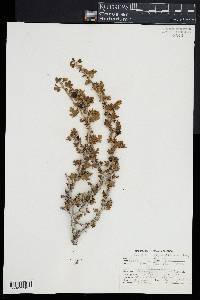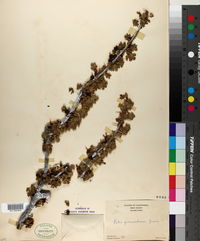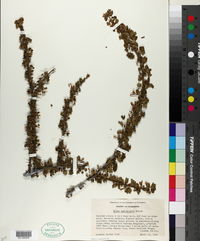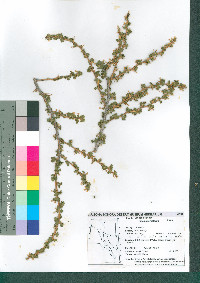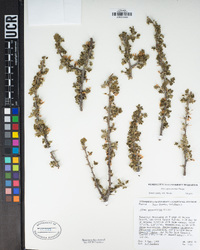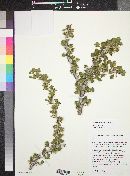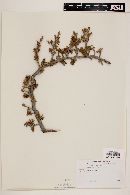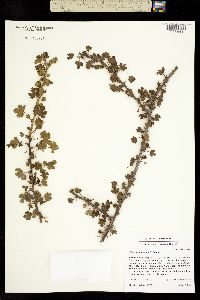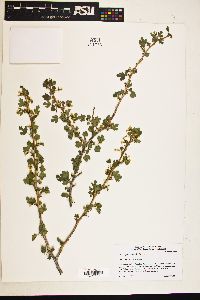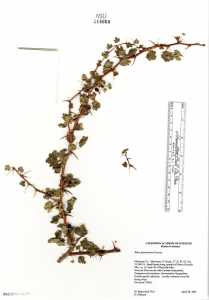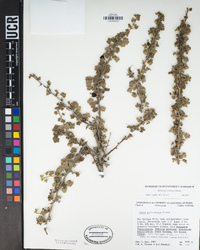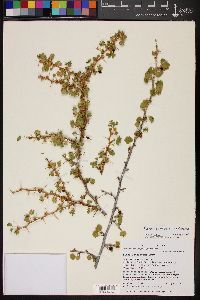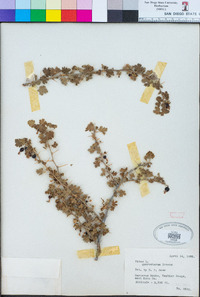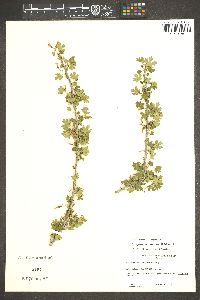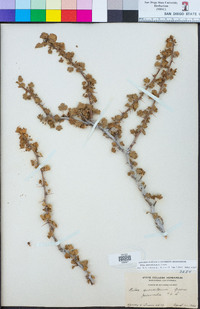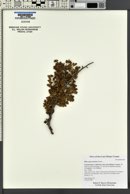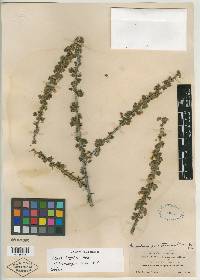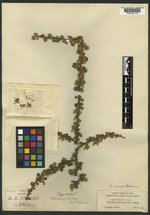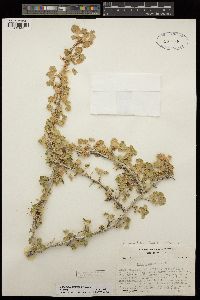Ribes quercetorum
|
|
|
|
Family: Grossulariaceae
Oakwoods Gooseberry, more...rock gooseberry
[Grossularia quercetora (Greene) Coville & Britt., moreRibes congdonii Heller] |
Plants 0.6-1.5 m. Stems arched, spreading, puberulent; spines at nodes usually 1, 5-15 mm; prickles on internodes absent. Leaves: petiole 1-3 cm, puberulent, stipitate-glandular; blade roundish, deeply 3-lobed, cleft 1/2+ to midrib, sometimes with 2 shorter lobes proximally, 1-3 cm, base truncate to cordate, surfaces puberulent and stipitate-glandular, lobes cuneate, rounded, margins acutely 2-4-toothed, apex blunt-toothed. Inflorescences spreading, 2-3-flowered racemes, 1-1.5 cm, axis puberulent and glandular, flowers evenly spaced. Pedicels not jointed, 1-1.5 mm, densely puberulent and glandular; bracts broadly ovate, 1-1.5 mm, puberulent and glandular. Flowers: hypanthium yellow, tubular, 2-3 mm, puberulent; sepals not overlapping, reflexed, yellow, narrowly oblong, 3 mm; petals connivent, erect, white, narrowly obovate, not conspicuously revolute or inrolled, 1 mm; nectary disc not prominent; stamens slightly longer than petals; filaments linear, 1 mm, glabrous; anthers yellow, oval, 0.7-1 mm, apex with cup-shaped depression; ovary subglabrous; styles completely connate, 4.5 mm, glabrous. Berries palatable, black, globose, 7-8 mm, glabrous. Flowering Nov-May. Rocky slopes and canyon walls, dry slopes in woodlands; 0-2500 m; Ariz., Calif.; Mexico (Baja California). Ribes quercetorum occurs in the foothills of the Sierra Nevada, the inner Coast Ranges south to the western Colorado Desert in California (and into Baja California), and the mountains of south-central Arizona.
FNA 2009, Jepson 2012, Kearney and Peebles 1969 Duration: Perennial Nativity: Native Lifeform: Shrub General: Herbaceous or shrubby perennials, to 1.5 m tall, stems erect, and arching, with 1-3 spines, 5-15 mm long per each node, and puberulent internodes (the internodes lacking spines), with pubescent and somewhat glandular young twigs. Leaves: Alternate, palmately 3-5-lobed, 1-2 cm long, the lobes cone-shaped with rounded tips, blades with cordate bases, margins dentate to serrate or with 2-4 teeth and blunt-toothed apices, blades thin and gland-spotted (stipitate-glandular) with glandular hairs, blades deciduous, petiolate, and clustered on short, lateral branchlets, the petioles 1-3 cm long. Flowers: Yellow to cream, small, with 5 narrowly obovate, flattened petals to 1 mm long, sepals 5, narrowly oblong, spreading and reflexed, to 3 mm long, positioned alternate the petals and inserted at the top of the hypanthium, stamens slightly longer than the petals with linear, glabrous filaments to 1 mm long, anthers yellow, oval, to 1 mm long, the apices with cup-shaped depressions, ovaries subglabrous and inferior with 1 chamber and many ovules, styles 2, completely connate, to 4.5 mm long, hypanthium tube yellow, to 3 mm long, usually exceeding the ovary, flowers subtended by green, broadly ovate bracts 1-1.5 mm long, borne in axillary, 2-3 flowered racemes on hairy or glandular pedicels 1-1.5 mm long (these not jointed), the axis with evenly-spaced flowers. Fruits: Black, glabrous berries 7-8 mm in diameter. Ecology: Found on rocky, steep slopes and canyon walls, in oak-covered foothills or woodlands and chaparral communities, from 0-8,000 ft (0-2438 m); flowering March-May and November-April. Distribution: Arizona, California; Mexico. Ethnobotany: Berries eaten fresh, boiled into a jelly, or dried and stored for later use. Etymology: Ribes comes from the Syrian or Kurdish ribas, which was derived from an old Persian word, and quercetorum means of oak woods. Synonyms: Glossularia quercetorum Editor: LCrumbacher2012 |






